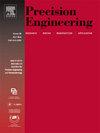Surface oxidation properties of GaN wafers in chemical magnetorheological polishing process by ultrasonic action
IF 3.5
2区 工程技术
Q2 ENGINEERING, MANUFACTURING
Precision Engineering-Journal of the International Societies for Precision Engineering and Nanotechnology
Pub Date : 2025-03-22
DOI:10.1016/j.precisioneng.2025.03.019
引用次数: 0
Abstract
To overcome the difficulty of ultraprecision processing of GaN wafers, an ultrasonic chemical magnetorheological composite polishing method using the ultrasonic Fenton method is proposed. The effects of the catalyst type, catalyst concentration and oxidant concentration on the generation of the hydroxyl radical ·OH by ultrasonic Fenton were examined, and the reaction principle of ultrasonic Fenton was determined by using the ·OH and Fe2+ content as the main evaluation indices. Compared with those of the ultrasonic Fenton/Fenton reaction under the same conditions, the oxidation‒reduction potential, temperature, ·OH content and Fe2+ content all continuously increased within 60 min; thus, ultrasonication promoted the Fenton reaction. A higher catalyst concentration correlated to a higher ionised Fe2+ content. A high ·OH content was rapidly generated at the beginning of the reaction, and the ·OH content subsequently decreased after the rapid consumption of the oxidant as the reaction proceeded. The amount of O on the GaN surface increased after oxidation, and the main product of the oxide layer on the GaN surface was Ga2O3. Comparative polishing tests have shown that the combination of ultrasound and Fenton action results in higher polishing efficiency and quality.

超声作用下化学磁流变抛光过程中氮化镓晶片表面氧化特性研究
为了克服GaN晶圆超精密加工的困难,提出了一种基于超声芬顿法的超声化学磁流变复合抛光方法。考察了催化剂类型、催化剂浓度和氧化剂浓度对超声芬顿法生成羟基自由基·OH的影响,并以·OH和Fe2+含量为主要评价指标,确定了超声芬顿法的反应原理。与相同条件下超声Fenton/Fenton反应相比,60 min内氧化还原电位、温度、·OH含量、Fe2+含量均持续升高;因此,超声波促进了Fenton反应。催化剂浓度越高,Fe2+离子含量越高。反应开始时迅速生成较高的·OH含量,随着反应的进行,氧化剂迅速消耗,·OH含量随之下降。氧化后GaN表面的O含量增加,GaN表面氧化层的主要产物为Ga2O3。对比抛光试验表明,超声和Fenton联合作用可提高抛光效率和抛光质量。
本文章由计算机程序翻译,如有差异,请以英文原文为准。
求助全文
约1分钟内获得全文
求助全文
来源期刊
CiteScore
7.40
自引率
5.60%
发文量
177
审稿时长
46 days
期刊介绍:
Precision Engineering - Journal of the International Societies for Precision Engineering and Nanotechnology is devoted to the multidisciplinary study and practice of high accuracy engineering, metrology, and manufacturing. The journal takes an integrated approach to all subjects related to research, design, manufacture, performance validation, and application of high precision machines, instruments, and components, including fundamental and applied research and development in manufacturing processes, fabrication technology, and advanced measurement science. The scope includes precision-engineered systems and supporting metrology over the full range of length scales, from atom-based nanotechnology and advanced lithographic technology to large-scale systems, including optical and radio telescopes and macrometrology.

 求助内容:
求助内容: 应助结果提醒方式:
应助结果提醒方式:


